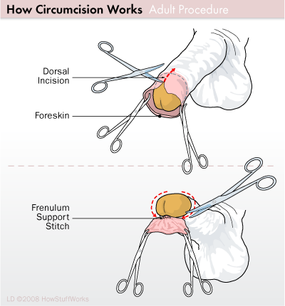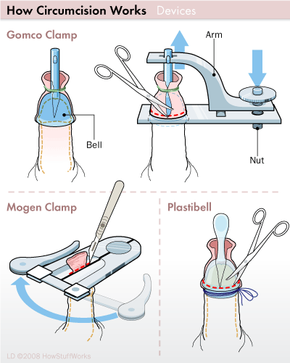Circumcision Procedure
If you do decide to circumcise yourself or your son, don't go for a discount job down in Kenya. Studies have shown that circumcisions performed in Africa with dull, unclean blades wielded by unschooled traditional practitioners result in complication rates of up to 35 percent, with 6 percent of those circumcisions causing permanent problems. To make matters worse, most of the Kenyan patients (boys are circumcised generally between the ages of 8 and 17) don't have the benefit of anesthesia.
That's the bad news. The good news is that if circumcisions are performed with clean, sharp instruments by trained professionals, the procedure itself is fairly safe and simple. Most are performed with no serious problems or complications. There is the chance that the patient may experience pain, bleeding, infection or irritation, but the most likely scenario is discomfort during the healing process.
Advertisement
For infant circumcision, the baby is placed on his back and his arms and legs are strapped down to prevent movement during the procedure. The baby will either have a topical anesthetic applied to the surface of the penis or have numbing agents injected into the penis or around its base.
The person performing the procedure can choose from one of several different clamps or specialized devices -- most often the Gomco clamp, Mogen clamp or Plastibell device. While there are differences in these devices, they perform the same basic function: separating the glans from the foreskin, protecting the glans, and crushing or cutting a ring of skin from the penis. The clamps provide for an immediate procedure, while the Plastibell device stays attached for several days before falling off.
If all goes as planned, the child will feel better (although probably irritable) in three to four days. The appearance of the area will improve in a week or so, but the baby can be taken home the same day as the procedure.

An infant's newly circumcised penis must be kept very clean. Often it's bandaged or covered with gauze or petroleum jelly to prevent fecal matter in the baby's diaper from coming into contact with the still-healing penis and creating infection.
In adult circumcision, a dorsal slit is usually made (cutting from the top of the skin -- the opening -- down toward the corona, the rounded border at the base of the glans) followed by a support stitch at the frenulum. The foreskin is held away from the penis and carefully cut off. The remaining skin is then sutured around the glans. The entire process takes about 30 minutes. The patient should avoid sexual activity for a couple weeks to ensure the penis is completely healed.
Next, we'll take a look at some more arguments for and against circumcision.
